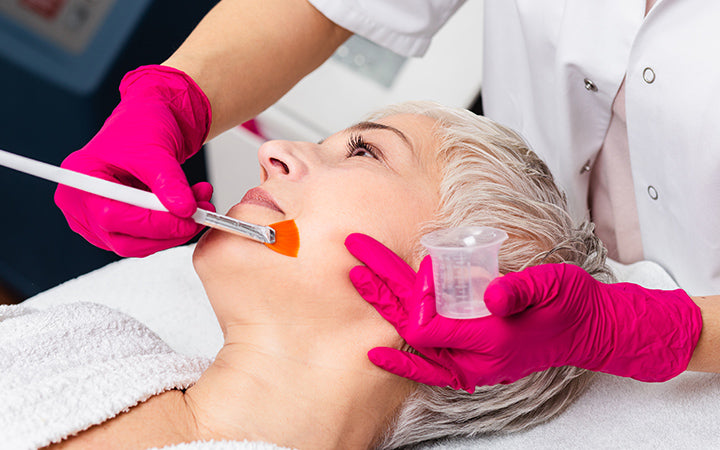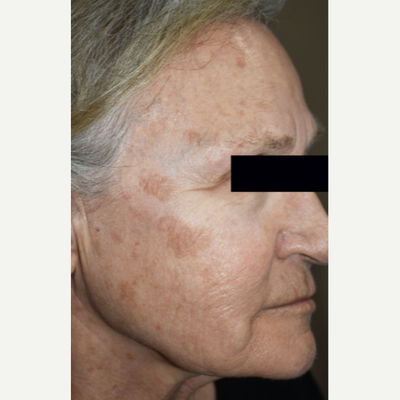Laser Revolution: Experience SupErficial Peels & Frac3 Resurfacing
Laser is a highly advanced and effective method of hair removal. It is completely safe and has been approved by the FDA. With Laser, you can permanently reduce hair growth in all areas of the body.
What is Laser Treatment?
It is a hair removal treatment that uses a laser to target the hair follicles. The laser emits a beam of light that penetrates the skin and is absorbed by the pigment in the hair follicle. This damages the hair follicle and prevents further hair growth.
How does it work?
The laser targets the hair follicles with a highly concentrated beam of light. The laser is attracted to the pigment in the hair follicle, which absorbs the light and heats up. This heat destroys the hair follicle, preventing future hair growth. Laser is effective on most hair types and skin tones.
A specialized device guides the laser to the treated area during the procedure. The length of the procedure depends on the size of the area being treated but typically takes only a matter of minutes. Many patients experience a slight discomfort during the procedure, but it is generally well-tolerated.
Laser treatment is an advanced and highly effective method of hair removal. Its ability to permanently reduce hair growth makes it an excellent choice for anyone looking to eliminate unwanted hair.

SupErficial Peels
If you're looking for a simple and effective way to rejuvenate your skin, SupErficial Peels could be the perfect solution. With their ability to exfoliate and stimulate the skin, these peels can improve the appearance of fine lines, wrinkles, and uneven skin tone.
What are SupErficial Peels?
SupErficial Peels are a chemical peel that uses mild acids to exfoliate the top layer of skin. This process stimulates collagen production and promotes cell renewal, which can improve the overall texture and appearance of the skin. Superficial Peels are safe for all skin types and can be used on the face, neck, and hands.
Benefits of SupErficial Peels
- Reduces the appearance of fine lines and wrinkles
- Improves skin texture and tone
- Lightens hyperpigmentation and dark spots
- Reduces acne and acne scarring
- Minimizes pore size
SupErficial Peels are a quick and easy treatment that can be done in minutes, making it a popular choice for people with busy lifestyles. It is important to note that multiple treatments may be necessary to achieve desired results.
If you're interested in trying SupErficial Peels, consult a licensed aesthetician or dermatologist who can help determine if this treatment is right for you.

Frac3 Resurfacing
If you're looking for an effective way to improve your skin's texture, Frac3 Resurfacing could be the solution. This innovative treatment utilizes laser technology to target damaged skin, leaving you smoother, clearer skin.
What is Frac3 Resurfacing?
Frac3 Resurfacing is a non-invasive laser treatment that targets damaged skin cells. By using laser energy to stimulate collagen production and promote cell renewal, this treatment can improve skin texture and reduce the appearance of fine lines and wrinkles. Frac3 Resurfacing uses specially designed fractional technology to precisely deliver laser energy, ensuring the surrounding skin is undamaged.
Benefits of Frac3 Resurfacing
- Improves skin texture by reducing the appearance of fine lines and wrinkles
- Targets hyperpigmentation, dark spots, and sun damage
- Non-invasive and requires little to no downtime
- Stimulates the body's natural collagen production process
Frac3 Resurfacing is a quick and easy procedure that can be completed in as little as 30 minutes, making it a popular choice for people with busy lifestyles. While some people may see results after just one treatment, undergoing multiple treatments for optimal results is typically recommended. If you're interested in trying Frac3 Resurfacing, consult a licensed aesthetician or dermatologist to determine if this treatment is right for you and your skin type.
Who is a Candidate?
If you're looking to improve the texture and overall appearance of your skin, Laser could be an effective treatment option. However, not everyone is a good candidate for this laser resurfacing procedure. Here's what you need to know about who is a good candidate for Laser Treatment.
Skin Types Suited for Laser Treatment
Laser Treatment is best suited for individuals with fair to medium skin tones and those not prone to scarring or keloid formation. People with darker skin tones or those prone to scarring may not be suitable for this type of laser treatment.
Conditions treated by Laser Treatment
Laser Treatment can treat various skin concerns, including fine lines, wrinkles, sun damage, hyperpigmentation, and dark spots. It is also effective at improving skin texture and reducing the overall appearance of scars.
It's important to note that Laser Treatment is not recommended for individuals with active skin infections or those who have a history of skin cancer. Additionally, pregnant women or individuals who are currently taking certain medications may not be good candidates for this type of laser treatment.
If you're interested in Laser Treatment, it's essential to consult with a licensed aesthetician or dermatologist to determine whether this treatment is right for you and your skin type. They can also recommend alternative treatments if Laser Treatment is unsuitable for you.

What to Expect During Your Laser Treatment
Here's a breakdown of what you can expect before and during the treatment.
Before treatment preparations
Before the Laser Treatment procedure, your aesthetician or dermatologist will evaluate your skin and determine if you're a suitable candidate. If you're a good candidate, they'll discuss the pre-treatment preparations you need to take. This may include avoiding sun exposure, certain medications or supplements, and discontinuing certain skincare products. They may also recommend skipping makeup on the procedure's day.
During treatment experience
During the Laser Treatment, your skin will be cleansed thoroughly, and a topical numbing cream may be applied to ensure you're comfortable during the procedure. The laser device will then be moved over your skin, targeting the areas of concern. The procedure typically takes around 30 minutes to an hour.
You may feel a warm or mild prickling sensation during the treatment, but it should not be painful. After the procedure, your skin may be pink or slightly swollen, and you may experience some mild discomfort or itchiness, which is normal. Your aesthetician or dermatologist will provide post-treatment instructions to ensure you recover properly.
Overall, Laser Treatment can be an excellent choice for improving the texture and appearance of your skin. Always consult a licensed professional to determine if this treatment suits your skin type and concerns.

Recovery Period and Aftercare
What to Expect During the Recovery Period
After the procedure, your skin may be pink or slightly swollen, and you may experience some mild discomfort or itchiness, which is normal. It's important to avoid sun exposure and apply a broad-spectrum sunscreen to the treated area to prevent further damage to your skin. Depending on the intensity of your treatment, the recovery period will take anywhere from a few days to several weeks.
Post-Treatment Aftercare
Your aesthetician or dermatologist will give post-treatment instructions to ensure you recover properly. These may include:
- Applying a moisturizer to the treated area
- Drinking plenty of water to keep your skin hydrated
- Avoiding direct sun exposure for at least a week following treatment
- Avoiding hot showers or baths until your skin has fully healed
- Avoiding strenuous exercise or activities that may cause sweating for at least 24 hours post-treatment

How Often Should You Get Laser Treatment?
If you're considering Laser Treatment, you may be wondering about the frequency of treatments and the long-term benefits. Here's what you need to know:
Frequency of treatments
The frequency of Laser Treatment treatments will depend on several factors such as the severity of your skin concerns, desired results, and skin type. Typically, most people undergo three to six treatments spaced four to six weeks apart. However, this may vary depending on your specific situation.
Long term benefits of Laser Treatment
Laser Treatment can provide long-term benefits for your skin, such as improved texture, reduced fine lines and wrinkles, and an overall more youthful appearance. However, it's important to remember that this treatment is not a one-time fix. To maintain your results, you'll need to undergo periodic maintenance treatments. Your aesthetician or dermatologist can help you develop a personalized treatment plan to ensure your skin stays healthy and radiant.
Remember, the key to achieving optimal results with Laser Treatment is consistency. Stick to your treatment plan and follow your post-treatment instructions carefully to ensure the best possible outcomes. Also, always consult with a licensed professional to determine the best treatment plan for your skin type and concerns.
Risks and Side Effects of Laser Treatment
If you're considering Laser Treatment, it's important to understand the potential risks and side effects associated with this treatment. While Laser Treatment is generally safe, it can cause some side effects. Here's what you need to know:
Potential side effects of Laser Treatment
- Redness and swelling: After Laser Treatment, you may experience redness and swelling in the treatment area. This is completely normal and usually resolves within a few days.
- Blistering: In rare cases, Laser Treatment can cause blistering. If you experience blistering after treatment, contact your aesthetician or dermatologist immediately.
- Pigment changes: Laser Treatment can cause changes in skin color, especially in patients with darker skin tones. Your aesthetician or dermatologist can help you determine if you are at risk for pigment changes and recommend the appropriate treatment plan.
Mitigating risks
To minimize your risk of side effects, it's important to choose a licensed professional with Laser Treatment experience. Your aesthetician or dermatologist can also provide you with pre- and post-treatment instructions to help reduce your risk of complications.
Laser Treatment can be a safe and effective way to improve your skin's appearance. However, like any medical procedure, it does carry some risks. By understanding the potential side effects and following your aesthetician or dermatologist's instructions, you can help ensure a successful outcome.

Is Laser Treatment right for you?
Whether or not Laser Treatment is right for you depends on several factors, including your skin type, the severity of your skin concerns, and your overall health. It is important to consult with a licensed professional to determine if you are a good candidate for the procedure.
Frequently Asked Questions
Q: How long does Laser Treatment take?
A: The length of the treatment will depend on the size of the area being treated, but most sessions take between 15 and 45 minutes.
Q: Does Laser Treatment hurt?
A: Most patients report feeling a mild discomfort during the procedure, but topical anesthetic can be applied to minimize any pain.
Q: How many sessions are required to see results?
A: The number of sessions required will vary depending on the severity of your skin concerns and your desired results. Consult with your aesthetician or dermatologist to determine the best treatment plan for you.
Laser Treatment can be a safe and effective way to improve your skin's appearance. Understanding the potential risks and side effects and consulting with a licensed professional is essential to ensure a successful outcome.
